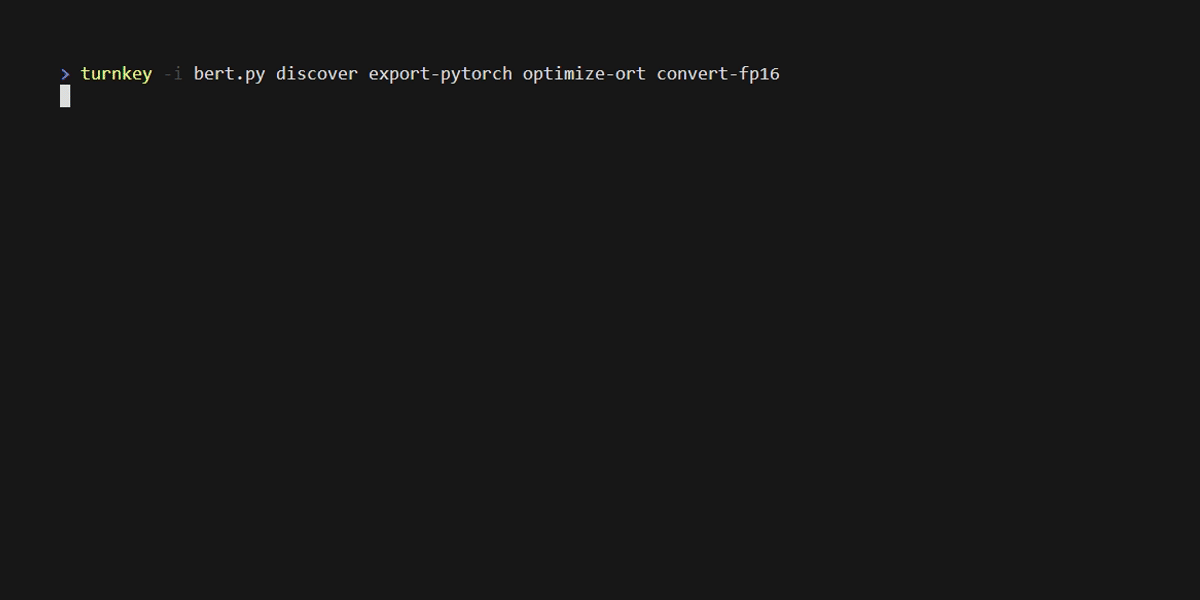Notice: TurnkeyML has just gone through a major refresh of its interfaces and source code.
We are on a mission to make it easy to use the most important tools in the ONNX ecosystem. TurnkeyML accomplishes this by providing a no-code CLI, turnkey, as well as a low-code API, that provide seamless integration of these tools.
The easiest way to get started is:
pip install turnkeyml- Copy a PyTorch example of a model, like the one on this Huggingface BERT model card, into a file named
bert.py.
from transformers import BertTokenizer, BertModel
tokenizer = BertTokenizer.from_pretrained('bert-base-uncased')
model = BertModel.from_pretrained("bert-base-uncased")
text = "Replace me by any text you'd like."
encoded_input = tokenizer(text, return_tensors='pt')
output = model(**encoded_input)turnkey -i bert.py discover export-pytorch: make a BERT ONNX file from thisbert.pyexample.
Here's turnkey in action: BERT-Base is exported from PyTorch to ONNX using torch.onnx.export, optimized for inference with onnxruntime, and converted to fp16 with onnxmltools:
Breaking down the command turnkey -i bert.py discover export-pytorch optimize-ort convert-fp16:
turnkey -i bert.pyfeedsbert.py, a minimal PyTorch script that instantiates BERT, into the tool sequence, starting with...discoveris a tool that finds the PyTorch model in a script and passes it to the next tool, which is...export-pytorch, which takes a PyTorch model and converts it to an ONNX model, then passes it to...optimize-ort, which usesonnxruntimeto optimize the model's compute graph, then passes it to...convert-fp16, which usesonnxmltoolsto convert the ONNX file into fp16.- Finally, the result is printed, and we can see that the requested
.onnxfiles have been produced.
All without writing a single line of code or learning how to use any of the underlying ONNX ecosystem tools 🚀
The turnkey CLI provides a set of Tools that users can invoke in a Sequence. The first Tool takes the input (-i), performs some action, and passes its state to the next Tool in the Sequence.
You can read the Sequence out like a sentence. For example, the demo command above was:
> turnkey -i bert.py discover export-pytorch optimize-ort convert-fp16
Which you can read like:
Use
turnkeyonbert.pytodiscoverthe model,exportthepytorchto ONNX,optimizethe ONNX withort, andconvertthe ONNX tofp16.
You can configure each Tool by passing it arguments. For example, export-pytorch --opset 18 would set the opset of the resulting ONNX model to 18.
A full command with an argument looks like:
> turnkey -i bert.py discover export-pytorch --opset 18 optimize-ort conver-fp16
The easiest way to learn more about turnkey is to explore the help menu with turnkey -h. To learn about a specific tool, run turnkey <tool name> -h, for example turnkey export-pytorch -h.
We also provide the following resources:
- Installation guide: how to install from source, set up Slurm, etc.
- User guide: explains the concepts of
turnkey's, including the syntax for making your own tool sequence. - Examples: PyTorch scripts and ONNX files that can be used to try out
turnkeyconcepts. - Code organization guide: learn how this repository is structured.
- Models: PyTorch model scripts that work with
turnkey.
turnkey is used in multiple projects where many hundreds of models are being evaluated. For example, the ONNX Model Zoo was created using turnkey.
We provide several helpful tools to facilitate this kind of mass-evaluation.
turnkey will iterate over multiple inputs if you pass it a wildcard input.
For example, to export ~1000 built-in models to ONNX:
> turnkey models/*/*.py discover export-pytorch
All build results, such as .onnx files, are collected into a cache directory, which you can learn about with turnkey cache -h.
turnkey collects statistics about each model and build into the corresponding build directory in the cache. Use turnkey report -h to see how those statistics can be exported into a CSV file.
This repository is home to a diverse corpus of hundreds of models, which are meant to be a convenient input to turnkey -i <model>.py discover. We are actively working on increasing the number of models in our model library. You can see the set of models in each category by clicking on the corresponding badge.
Evaluating a new model is as simple as taking a Python script that instantiates and invokes a PyTorch torch.nn.module and call turnkey on it. Read about model contributions here.
The build tool has built-in support for a variety of interoperable Tools. If you need more, the TurnkeyML plugin API lets you add your own installable tools with any functionality you like:
> pip install -e my_custom_plugin
> turnkey -i my_model.py discover export-pytorch my-custom-tool --my-args
All of the built-in Tools are implemented against the plugin API. Check out the example plugins and the plugin API guide to learn more about creating an installable plugin.
We are actively seeking collaborators from across the industry. If you would like to contribute to this project, please check out our contribution guide.
This project is sponsored by the ONNX Model Zoo special interest group (SIG). It is maintained by @danielholanda @jeremyfowers @ramkrishna @vgodsoe in equal measure. You can reach us by filing an issue.
This project is licensed under the Apache 2.0 License.
TurnkeyML used code from other open source projects as a starting point (see NOTICE.md). Thank you Philip Colangelo, Derek Elkins, Jeremy Fowers, Dan Gard, Victoria Godsoe, Mark Heaps, Daniel Holanda, Brian Kurtz, Mariah Larwood, Philip Lassen, Andrew Ling, Adrian Macias, Gary Malik, Sarah Massengill, Ashwin Murthy, Hatice Ozen, Tim Sears, Sean Settle, Krishna Sivakumar, Aviv Weinstein, Xueli Xao, Bill Xing, and Lev Zlotnik for your contributions to that work.







